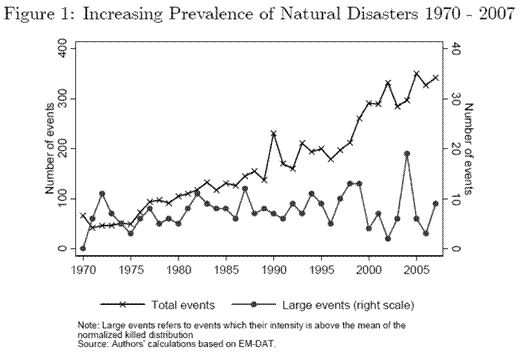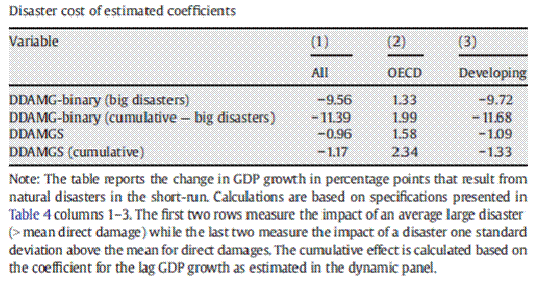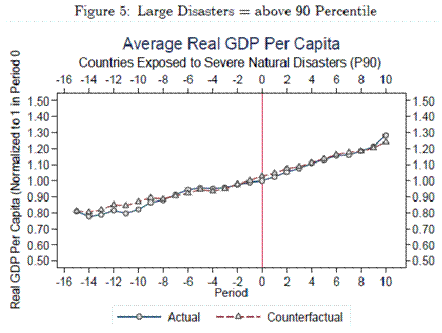By Ilan Noy
Today, we’re fortunate to have Ilan Noy, Associate Professor of Economics at the University of Hawai’i, as a Guest Contributor.
In the last 14 months, we have seen a spate of very large earthquakes which began with the unprecedented devastation caused by the earthquake in Haiti (1/10/10) — the most destructive natural disaster in modern history (relative to national population), continued with the unusually strong earthquake in Chile (2/27/10), to the most recent events generated by the earthquake in Sendai, Japan.
The horrific toll of this disaster is not yet clear (both in terms of fatalities and physical damage) and the nuclear crisis triggered by this event is still unfolding. Econbrowser readers, however, are probably already asking what will be the likely economic impact of this disaster. Remarkably, in spite of a spate of catastrophic disasters in the last decade (the East Asian tsunami of 2004, the Kashmir earthquake of 2005, and the Sichuan earthquake in 2008 to name a few), we have a fairly limited knowledge of the likely macroeconomic impacts of these events.
Before discussing these impacts, however, it is useful to note that while the most widely used dataset on disasters (EM-DAT) shows that their incidence has been growing over time, this increase is probably driven by improved reporting of milder events; truly large events do not show a similar trend.

Figure 1 taken from Cavallo et al. (2010).
Direct Damage from Natural Disasters
Direct damages — i.e., the damage to fixed assets and capital, to raw materials and extractable natural resources, and most importantly mortality and morbidity — are typically much larger in less developed countries, and countries with a weakened institutional capacity. A comparison of the damages caused by the 2010 earthquakes in Haiti and Chile easily demonstrates this point. The dramatically different outcomes, 240,000 people dead as compared with around 500, originated at least partially from different policies, institutional arrangements, and economic conditions. This makes the Sendai earthquake unusual, since it caused very significant damage in a very prosperous country, and one that is typically considered very well prepared to mitigate these events. While the final death toll is still unclear, it appears it will be quite significantly larger than the Kobe earthquake of 1995, the most fatal natural disaster to hit a developed country in many years (when about 6400 people died).
Indirect Damages in the Short- and Long-Run
The indirect damages from a natural disaster refer to the impact on economic activity, in particular the production of goods and services, that will not take place following the disaster and because of it. These indirect damages may be caused by the direct damages to physical infrastructure (for example, the damage to the fishing fleet in the Sendai area), or because reconstruction pulls resources away from production (for example, the problems experienced by several industries as a result of rolling blackouts instituted to redirect electricity to the affected area). If significant enough, these costs can be accounted for in the aggregate by examining the overall performance of the economy, as measured through the most relevant macroeconomic variables, in particular GDP, the fiscal accounts, consumption, investment, the balance of trade and the balance of payments. Economists, remarkably, have only recently started attempting to quantify these costs and explain their magnitudes (recent surveys of this new literature are Cavallo and Noy, and Sharma).
As a result of several recent research projects (e.g., a World Bank project), the evidence on the short-run growth effects of disasters appears fairly clear by now. Findings in Noy (2009) are representative of this emerging consensus. Countries with higher per capita incomes, higher literacy rate, and better institutions are not only less vulnerable to the initial impact of the disaster, but their macro-economy is less affected as well (see table below). In particular, there is no evidence from recent data that even large natural disasters have any measurable adverse impact on the national economy of rich developed countries like Japan. In contrast, poorer less-developed countries do face significant short-run costs of disasters, and these can translate into significant income losses.

Table taken from Noy (2009).
When compared to the research on short-run indirect impacts, the literature on the long-run effects of natural disasters is scant and its results inconclusive. The most recent attempts to evaluate the long-run impact of disasters on GDP suggest that there is no evidence of an adverse impact (if anything, a few papers argue that disasters provide an impetus for ‘creative destruction’ dynamics that lead to increased growth). For example, Cavallo et al (2010) construct counterfactual synthetic countries unaffected by disasters, and find no significant long-run effect of disasters on per capita GDP (even for very large disasters).

Figure 5 taken from Cavallo et al., 2010).
And What About Japan?
Given the findings described above, one can conclude that the likely indirect impacts of this horrific earthquake/tsunami event on growth in the Japanese economy will be quite minimal. The Japanese government and the Japanese people have access to large amounts of human and financial resources that can be directed toward a rapid and robust reconstruction and rebuilding of the affected region. Neither do we have any evidence to suggest that the earthquake is likely to have any enduring monetary effects.
This observation, however, does not preclude enduring regional impacts. There is almost no research on this question, but some preliminary evidence suggests that similar large natural shocks can have important regional consequences. One widely mentioned prediction is that the population of New Orleans is unlikely to recover from the dramatic exodus of people from the region after Hurricane Katrina. Coffman and Noy argue that a similar and apparently semi-permanent decrease in population is observable for an Hawaiian island that was hit by a destructive hurricane in 1992.
In addition to these potentially permanent regional impacts, of course, this disaster may have impact on other macro-economic aggregates. The fiscal expansion that will follow this disaster will further increase the Japanese government’s debt levels, but since this debt largely stays in Japan, and since households (especially credit-constrained households — see Sawada and Shimizutani) are likely to ‘tighten their belts’ and reduce consumption temporarily, these other affects are unlikely to be enduring as well.
One caveat is worth mentioning here: We still do not know what will be the impact of the enfolding crisis in the various nuclear reactors that have been affected. The analysis above ignored this danger, though the still present devastation in Chernobyl attests to its potentially destructive powers.
This post written by Ilan Noy.
Very interesting analysis, but a frightening and tragic time for Japan.
Noy doesn’t say much about the effects on ROW economies, but these are likely to be salutory. Even now, the yen is showing signs of strength, which may seem counter-intuitive to some, but is the expected result of reduced loans from Japan to ROW. This could amount to as much as a couple of hundred billion dollars in added stimulus for ROW economies.
“The most recent attempts to evaluate the long-run impact of disasters on GDP suggest that there is no evidence of an adverse impact (if anything, a few papers argue that disasters provide an impetus for ‘creative destruction’ dynamics that lead to increased growth).”
This result is even more likely in today’s world of high unemployment and insufficient investment demand. The ‘crowding out’ that one might otherwise expect will not materialize unless the disaster precipitates expectations that the government will be unable to sustain additional debt. Since Japan is a net external creditor with regular excess savings, this result is improbable. Markets appear to agree with this assessment, as evidenced by the post-disaster behavior of the yen and yen-denominated interest rates.
The disaster is the toll in human suffering. The economic effects (which are much less important, but which are bound to be the focus of economists) are probably ambiguous for Japan and salutory for ROW.
Thanks.
A natural disaster can lead to a lot of spending and also to renewal of aged infrastructure. We should see this in this region of Japan because of where it is on Honshu and the nature of its economy. It might be different if this were northern Hokkaido or southern Kyushu.
Resources, willpower and effective government describe a huge difference between a place like Japan and its opposite Haiti.
A similar analysis has been done on plagues, notably the Black Death’s reduction of population and the tie between that and increased wages and labor mobility and even a connection to the general period of renewal in the Renaissance.
Japan may not unfold like other OECD disasters because of demographics. Japan has an aging population and strict immigration controls. The rebuilding effort will strain the available manpower and may damage output long term because the rebuilding might be dragged out over time. Certainly not Haiti like but still not the OECD norm.
Japan will recover, in time. They are a resourceful nation. The thing that may be different this time is the magnitude 9 of the quake itself. According to statistical analysis by the Jet Propulsion Lab, over the next 2 years or so, the Pacific Rim “Ring of Fire” can expect 1 magnitude 8 quake, and 10 magnitude 7 quakes, as follow-on quakes. Any one of these could cause significant further damage and disruption in another economy on the Pacific Rim, and potentially several of these 11 quakes could cause compounding disruptions. If JPL is anywhere close to correct, this becomes a ‘crap shoot’ with tremendous stakes.
Regarding the large events times series, is it just my eyes, or does it look like there are larger swings around the mean after (say) 1995?
I believe it was the NY Fed that estimated the negative economic effects of 9/11 had largely dissipated by early winter 2002. But here’s the thing…if economies can suffer large supply side shocks like earthquakes, floods and terrorist attacks, why is it that $4/gal gasoline can bring a country’s economy to its knees? Is it because disasters tend to be localized events rather than systemic breakdowns?
It seems reasonable that given that Japanese Real GDP has been declining recently, in the long term be a good thing since it will create jobs linked to the rebuilding and stimulate demand. However, I wonder how the tendency of countries to bounce back from natural disasters is linked to the ease with which a government can borrow money
Great, lets have a 9.0 quake under LA. It will be a big boon to the US economy.
I don’t understand comments that imply discussing reconstruction is the same as endorsing killing people to cause reconstruction. It’s the same economic analysis as when, for example, having a car that gets better mileage results in you driving more, thus eating up part of the gain from the efficiency. You can’t do economic thinking without thinking.
Will nuclear power falling out of affection increase oil prices? Or the factors below?
I think we are going into the second peak of this graph I made on February 6th, with Brent reaching 125-130 USD in early April. The first peak in the end of February was predicted accurately, as was drop in first half of March:
http://www.saposjoint.net/Forum/download/file.php?id=2609
After that, oil prices will drop again till beginning of May, than top out again in July, with Brent reaching 135-140 USD.
Continued spreading supply disruptions will be the main cause of this erratic price behavior, but perhaps QE3 will kick start Oil prices in July and then of course, QE3 will be doomed, and canceled. Let us see what will cause the oil price spike in July. Its easier to forecast aggregate behaviour or prices as they include all information, than specific causes that lead to certain prices.
That is known in forecasting as law of big numbers. The relative accuracy of forecast increases as sqrt(N) where N is the number of independent unpredictable events impacting future oil price.
Where are they going to get the capital from?
Japan is the most highly indebted industrial economy in the world.
To just assume that because it is the third largest economy in the world it can regenerate with minimal consequence is absurd. Japan faces very real and very significant financial constraints. Before you use statistics you need to assess the outliers and factors that differentiate the issue at hand from the mean result.
Noy writes:
When compared to the research on short-run indirect impacts, the literature on the long-run effects of natural disasters is scant and its results inconclusive. The most recent attempts to evaluate the long-run impact of disasters on GDP suggest that there is no evidence of an adverse impact (if anything, a few papers argue that disasters provide an impetus for ‘creative destruction’ dynamics that lead to increased growth). For example, Cavallo et al (2010) construct counterfactual synthetic countries unaffected by disasters, and find no significant long-run effect of disasters on per capita GDP (even for very large disasters).
This is one of the most serious errors that demand side aggregate accounting (Keynesianism and monetarism) foists on the world of economics. GDP does not measure wealth but spending. Wealth is actually the measure of the future income streams from an asset not the spending on the creation of that asset.
This error in thinking was illustrated over 150 years ago by Frederic Bastiat’s The Broken Window fallacy. The fallacy is veiled by demand side analysis, but if you see it from a supply side perspective, it becomes obvious. If you have an asset with an income stream, when that asset is destroyed you lose the income stream. Spending on another asset to replace the asset that was destroyed only returns us to the original income stream. Spending on an additional asset provides us with twice the income stream. The demand side fallacy is that spending on a new asset or on a replacement asset is analyzed the same. In the demand side aggregate spending is spending. Because of this error in the definition of wealth, demand side economists will see a growing economy after a disaster even though wealth has been destroyed and the people forced to poverty.
Andrew Teasdale:
“Where are they going to get the capital from?
Japan is the most highly indebted industrial economy in the world.”
Japan is a huge net lender to the rest of the world. They can get the capital by reducing loans abroad. That is exactly what is happening, and why the yen is rising. There are noises, however, that Japan will intervene in currency markets (i.e., loan more to ROW to inhibit the yen appreciation).
Ricardo:
I think it is an empirical question. Bastiat’s analysis was a big step forward for its time, but it does not consider persistent involuntary unemployment, demand-determined output, or the Keynesian multiplier. Some thought that analysis was surpassed – they were mistaken. Lucas should never have gotten the Nobel prize, and I’m sure he never would have if the current situation had arisen before it was awarded him.
So Don, you believe that destroying a nuclear power plant and rebuilding it is the same as building a second plant to double power production? Interesting!
Ricardo – you seem to deny the wisdom of Keynes’ proposition when he advocated having men dig holes in the ground and refill them. Well, clearly that can’t work unless we have involuntary unemployment and demand-constrained output, but the question can’t be settled using arguments as simple as Bastiat’s.
Don,
Bastiat simply demonstrates the foolishness of the policies. Settling the question is up to us. I certainly do not believe that perpetuating the stupidity that Bastiat exposes is any kind of solution.